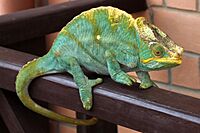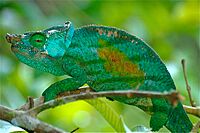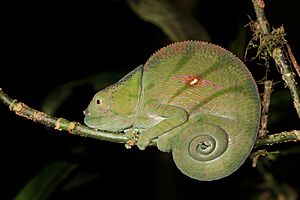Parson's chameleon facts for kids
Quick facts for kids Parson's chameleon |
|
|---|---|
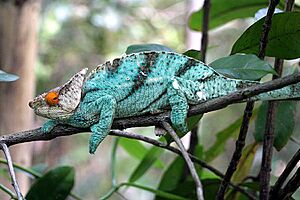 |
|
| Male C. p. parsonii, "orange eye" variant |
|
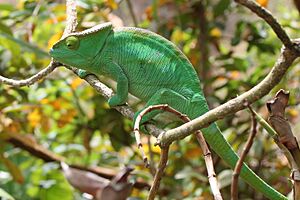 |
|
| Female C. p. parsonii | |
| Conservation status | |
| Scientific classification | |
| Genus: |
Calumma
|
| Species: |
parsonii
|
 |
|
| Synonyms | |
|
|
The Parson's chameleon (scientific name: Calumma parsonii) is a very large and colorful type of chameleon. It belongs to the Chamaeleonidae family. This amazing reptile lives only in eastern and northern Madagascar, which means it is endemic to that island. You can find it in humid forests, from low areas up to about 1,195 meters (3,921 feet) high. While it mostly lives in untouched forests, it can also be found in areas where trees have been disturbed. Compared to other chameleons, the Parson's chameleon is known for being very big, living a long time, and having a slow reproduction rate.
Contents
What's in a Name?
The name parsonii was given to this chameleon in 1824 by a scientist named Georges Cuvier. He chose this name to honor a British doctor named James Parsons.
Appearance and Size
The Parson's chameleon is often considered the heaviest chameleon in the world. It is also one of the longest, though the Malagasy giant chameleon can be even longer. Adult male Parson's chameleons usually weigh between 500 and 700 grams (about 1.1 to 1.5 pounds). They have a special helmet-like shape on top of their heads and two bumpy "horns" that run from above their eyes to their nose.
There are two main types, called subspecies, of the Parson's chameleon:
- The widespread Calumma p. parsonii: This type lives in both low and mid-level areas. It does not have spines along its back. These chameleons can grow up to 65 cm (26 inches) long, including their tail. Some reports even say they can be over 80 cm (31 inches), but these are not fully confirmed.
- The Calumma p. cristifer: This type is found in mid-level areas, especially around the Andasibe-Mantadia National Park. It has small spines along its back. These chameleons are usually lighter and grow up to 50 cm (20 inches) long, though some have been reported up to 60 cm (24 inches).
Color Variations
The Calumma p. parsonii subspecies has four main color types, often called morphs. Scientists are still figuring out if these are true subspecies or just different color forms. Each morph lives in a different area:
- "Orange eye" variant: Also known as "white-lipped," this type lives in lowlands. Males are usually green or turquoise with yellow or orange eyelids. Their heads can have different amounts of white.
- "Yellow lip" variant: Found in mid-level areas like the Ranomafana National Park. Males are mostly green or turquoise with a yellow edge around their mouth.
- "Yellow giant" variant: Lives in mid-level areas in the southern Alaotra-Mangoro region. Males are generally yellowish, especially their heads. Younger males might look greener.
- "Green giant" variant: Found in the Masoala National Park area. Males are mostly green or turquoise, including their eyelids and mouth edges.
Males of the C. p. cristifer subspecies do not have these distinct color variants. They are usually green or turquoise and often have a yellow-orange or rusty-orange spot on their side. When male chameleons feel stressed, their colors become duller or darker. Dark spots and three diagonal bars on their bodies also become more noticeable.
Female Parson's chameleons, in both subspecies and all variants, are smaller than males. They have a smaller casque (helmet-like shape) and no horns, or only very tiny ones. Females are typically greenish, but their exact shade can vary. C. p. cristifer females can also be brownish and might have a light spot on their side. When stressed, females tend to show some yellow, and can even become mostly yellow with green spots.
Young chameleons of both sexes look very similar. They can be brown, orangish, or green. No matter their age or sex, Parson's chameleons become paler when they sleep at night. This is a common behavior for most chameleons.
What They Eat
Parson's chameleons mostly eat small creatures without backbones, especially insects. However, they are not picky eaters and will sometimes catch small vertebrates like lizards and even tiny birds. This chameleon is a "sit-and-wait predator." This means it moves slowly and waits for its prey to come close before striking. They are usually quite inactive, but they become more active during their breeding season. There are some unconfirmed reports that they might occasionally eat plant material like leaves, flowers, and pollen. This is unusual for chameleons, but not unheard of, as some other large chameleons have been known to eat plants.
Life Cycle
Reproduction
Parson's chameleons breed at certain times of the year. Mating happens at the beginning of the rainy season. The female then lays a single group of eggs, called a clutch, at the end of the rainy season, about three to five months later. A female can lay eggs once a year, but often she might skip a year and lay eggs every other year instead. In one interesting case, a female laid eggs for several years in a row after mating only once. This suggests that female chameleons can store sperm inside their bodies for a long time and use it to fertilize many clutches of eggs. This ability is also seen in some other chameleon species.
A female lays between 20 and 60 eggs in each clutch. She buries them in a hole in the ground, about 30 cm (12 inches) deep. The eggs usually take a very long time to hatch, from 400 to 660 days. This is longer than any other known reptile species! In one amazing instance, a healthy baby chameleon hatched after 781 days. The time it takes for the eggs to hatch seems to depend on the weather, with warmer temperatures leading to a shorter incubation period than colder temperatures. When they first hatch, the young chameleons are typically only 7 to 11 cm (2.8 to 4.3 inches) long. They usually become old enough to reproduce when they are about three years old, but some can be ready as early as two years or as late as five years.
Life Span
The Parson's chameleon is one of the longest-living chameleon species. In the wild, males have been known to live for at least 9 years, and females for at least 8 years. Scientists estimate that they can live for 10 to 12 years in their natural habitat. In zoos or other controlled environments, some individuals have lived for 14 years. This is longer than any other confirmed chameleon species. It is even possible that some Parson's chameleons could live as long as 20 years!
Conservation Status
The IUCN (International Union for Conservation of Nature) considers the Parson's chameleon to be "near threatened." This means it could become endangered in the future if current threats continue. It lives across a large area, almost 40,000 square kilometers (15,000 square miles), and can be found in several protected areas. However, it seems there are not many of them in any given place. This might be partly because they like to rest high up in the forest canopy, making them hard to spot.
The biggest danger to this species is the ongoing loss of its habitat. This happens mainly because of "slash-and-burn agriculture" (where forests are cut down and burned to clear land for farming) and also from logging. The chameleon mostly needs untouched forests to survive, even though it can sometimes be found in disturbed areas like patches of tall trees in villages or coffee plantations.
Another threat is the unregulated collection of these chameleons for the pet trade. Since they reproduce slowly, taking too many from the wild can harm their populations. In the past, many Parson's chameleons were collected, which might have affected some groups of them. Since 1995, the Parson's chameleon has been listed on CITES Appendix II. CITES is an international agreement that controls the trade of wild animals and plants. Being on Appendix II means that legal international trade in this species can only happen with a special permit. Madagascar now has a limit on how many can be legally exported each year. However, in years when the export limit was zero, some illegal trade still happened.



